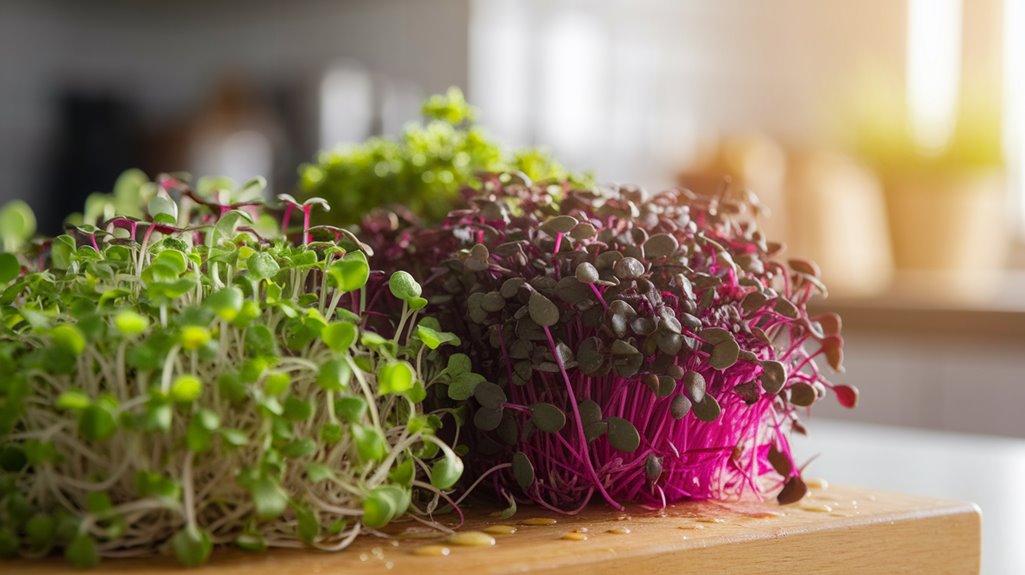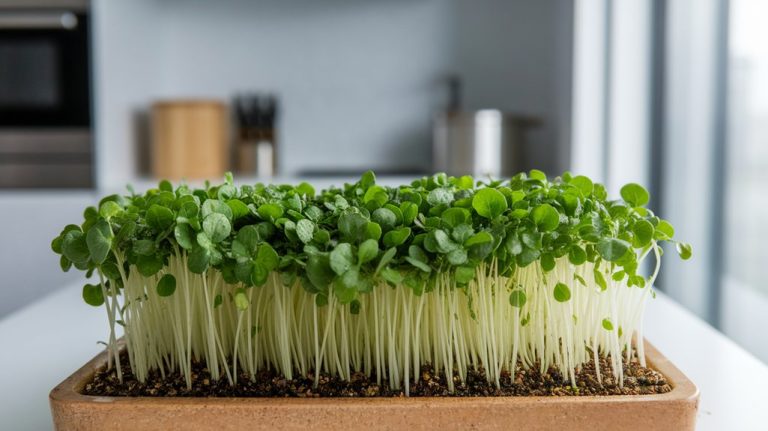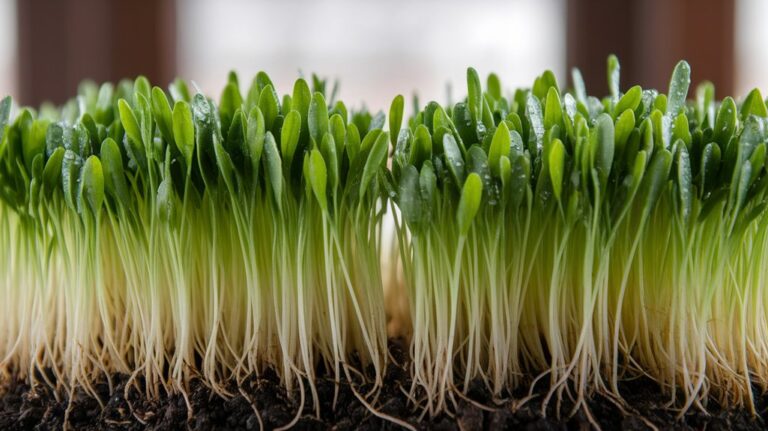How Microgreens Can Boost Your Immune System Naturally
Microgreens are incredibly powerful for boosting your immune system naturally. They’re rich in vitamins C, A, and D, which are essential for immune health. Plus, their high antioxidant content protects your cells from damage and reduces inflammation. Broccoli and radish microgreens, in particular, offer unique health benefits that support immune function. Incorporating these nutrient-dense greens into your diet can be an easy way to enhance your overall wellness. Discovering how to use them might surprise you.
Key Takeaways
- Microgreens are nutrient-dense, providing higher levels of essential vitamins and minerals crucial for immune health compared to mature plants.
- They are rich in Vitamin C, which stimulates white blood cell production to fight infections effectively.
- Antioxidants in microgreens, such as vitamins C and E, neutralize free radicals, reducing inflammation and promoting overall wellness.
- Specific varieties, like broccoli and radish microgreens, contain unique compounds that combat inflammation and enhance immune responses.
- Incorporating microgreens into meals boosts nutrient intake, supporting a robust immune system naturally.
What Are Microgreens?
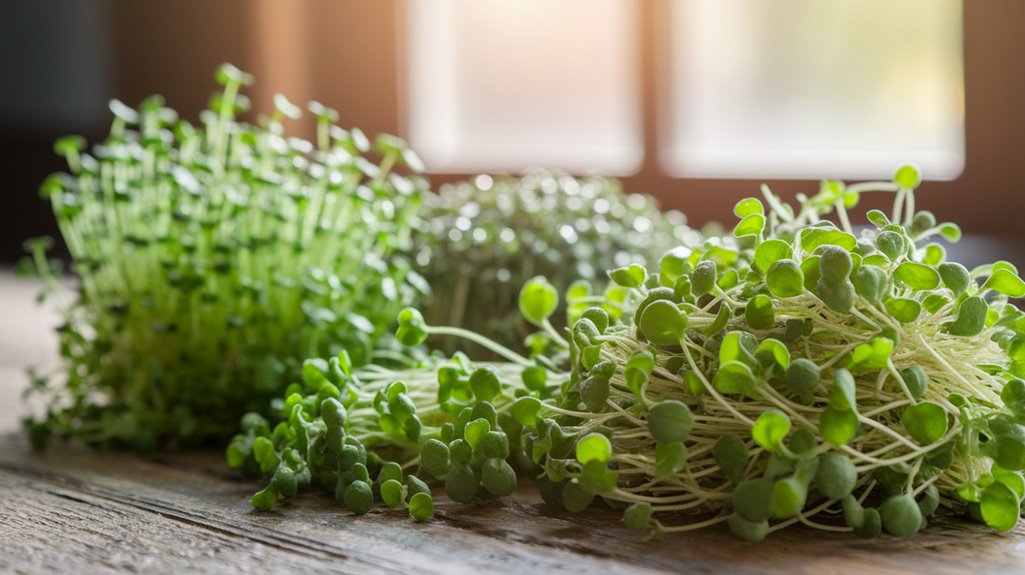
Microgreens are young, edible plants harvested just after the first true leaves develop, typically within 7 to 21 days after germination.
I’ve found that they encompass a variety of species, including arugula, radish, and basil, each offering distinct flavors and textures.
These tiny greens are cultivated in soil or hydroponically and require minimal space, making them perfect for urban gardening.
Research shows that microgreens pack a concentrated nutrient profile, often containing higher levels of vitamins, minerals, and antioxidants compared to their mature counterparts.
I appreciate how they can easily enhance various dishes, from salads to sandwiches.
With their vibrant colors and robust flavors, microgreens not only elevate the culinary experience but also represent a sustainable choice for health-conscious consumers.
Nutritional Benefits of Microgreens
These tiny greens are more than just a culinary delight; they offer impressive nutritional benefits that can significantly impact our health.
Studies show that microgreens pack a concentrated dose of vitamins, minerals, and antioxidants compared to their mature counterparts. For instance, they contain higher levels of vitamin C, E, and K, which are vital for various bodily functions.
Their rich phytochemical content also supports overall wellness, promoting better digestion and reducing inflammation. I’ve noticed that incorporating them into my meals not only enhances flavor but also boosts nutritional value.
Research indicates that just a small serving of microgreens can contribute to our daily intake of essential nutrients, making them an easy and effective addition to a health-conscious diet.
Key Vitamins and Minerals for Immunity
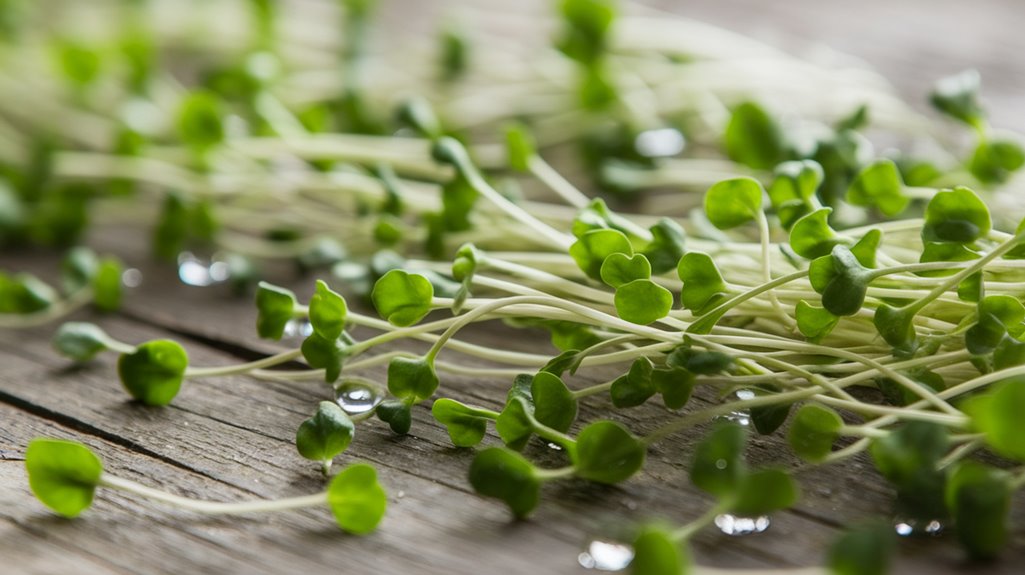
When it comes to supporting a robust immune system, certain vitamins and minerals play crucial roles in enhancing our body’s defenses.
For instance, vitamin C is well-known for its ability to stimulate the production of white blood cells, essential for fighting infections.
I also find that vitamin D is vital; research shows it can help regulate immune responses and reduce the risk of respiratory infections.
Zinc, another key mineral, is necessary for immune cell function and has been linked to decreased illness duration.
Additionally, vitamin A supports mucosal barriers, acting as a first line of defense against pathogens.
Incorporating microgreens, rich in these nutrients, into my diet helps ensure I’m getting the essential vitamins and minerals needed for optimal immune health.
Antioxidants and Their Role in Immune Health
Antioxidants are compounds that help protect our cells from damage caused by free radicals, which can compromise immune function.
I find it fascinating that certain foods, especially microgreens, are rich in these protective substances.
Understanding their sources and how they bolster our immune health can empower us to make better dietary choices.
Antioxidants Defined and Explained
The concept of antioxidants has gained significant attention in recent years, especially regarding their role in bolstering our immune health.
Antioxidants are compounds that neutralize free radicals—unstable molecules that can cause cellular damage and inflammation. This damage can impair our immune system, making it less effective in fighting off infections and diseases.
Research shows that a diet rich in antioxidants can enhance the body’s defense mechanisms by reducing oxidative stress and promoting overall well-being.
Vitamins C and E, beta-carotene, and selenium are well-known antioxidants that play crucial roles in immune function.
Sources of Antioxidants
Many foods are packed with antioxidants that can significantly boost immune health. Incorporating these into my diet has made a noticeable difference.
Here are three excellent sources of antioxidants you might consider:
- Berries: Blueberries, strawberries, and raspberries are rich in flavonoids, which help combat oxidative stress.
- Nuts: Walnuts and pecans not only provide healthy fats but also contain high levels of antioxidants like vitamin E.
- Leafy Greens: Spinach and kale are loaded with vitamins A and C, both powerful antioxidants that support immune function.
Antioxidants and Immune Function
While I’ve learned that a variety of nutrients are crucial for maintaining a strong immune system, antioxidants stand out due to their unique ability to neutralize free radicals.
These unstable molecules can damage cells and contribute to inflammation, which can weaken immune function. Research shows that antioxidants, such as vitamins C and E, play a vital role in supporting immune health by enhancing the activity of immune cells.
For instance, vitamin C boosts the production of lymphocytes, which are essential for fighting infections. Incorporating microgreens into my diet, rich in antioxidants, has become a priority.
I’ve found that varieties like broccoli and radish microgreens not only add flavor but also provide a concentrated source of these powerful compounds, helping me maintain a robust immune system.
Popular Microgreens and Their Immune-Boosting Properties
As I explore the vibrant world of microgreens, I find it fascinating how these tiny plants pack a powerful punch when it comes to supporting our immune system.
Research shows that different microgreens offer unique benefits, making them a great addition to our diets. Here are three popular microgreens with impressive immune-boosting properties:
- Broccoli Microgreens: High in sulforaphane, these microgreens help combat inflammation and enhance our body’s defense mechanisms.
- Radish Microgreens: Packed with antioxidants and vitamins A, C, and E, they improve overall immune function and support skin health.
- Pea Shoots: Rich in vitamin C and folate, they can increase white blood cell production, vital for fighting infections.
Incorporating these into meals can truly enhance our health and resilience.
How to Grow Microgreens at Home
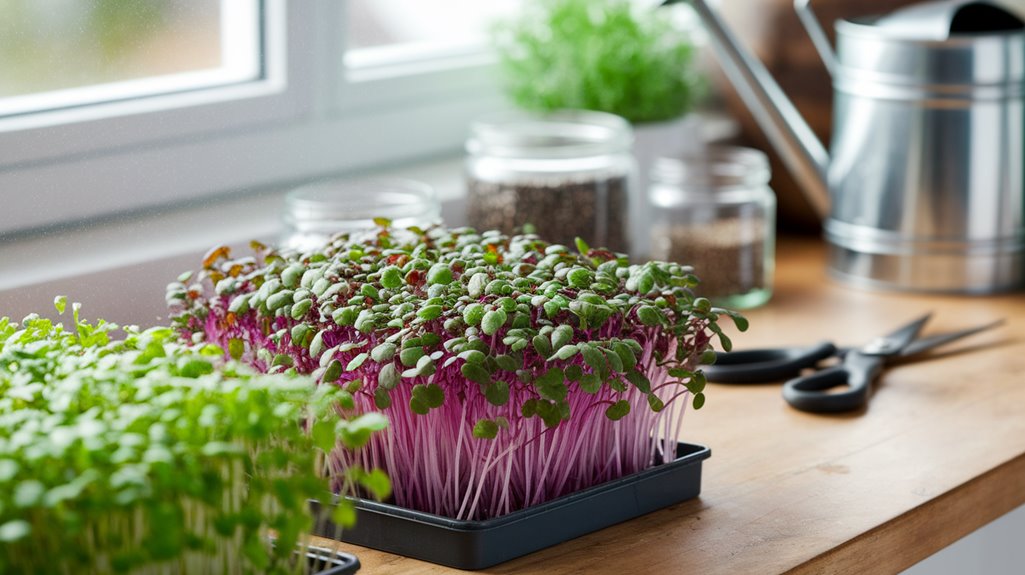
When I decided to grow microgreens at home, I quickly learned that choosing the right seeds is crucial for success.
I found that specific varieties like broccoli or radish aren’t only easy to grow but also packed with nutrients.
Additionally, creating ideal growing conditions—like proper light and moisture—ensures that my microgreens flourish and provide maximum health benefits.
Choosing Suitable Seeds
Choosing the right seeds is crucial for successfully growing microgreens at home, especially if you’re aiming to boost your immune system. Some seeds are packed with nutrients that can enhance your immunity, so it’s important to select wisely.
Here’s what I consider when choosing seeds:
- Nutritional Value: Look for seeds high in vitamins A, C, and E, as well as antioxidants, such as broccoli or kale.
- Germination Rate: Choose seeds with a high germination rate to ensure a successful crop. Varieties like radish or mustard germinate quickly.
- Pesticide-Free: Opt for organic seeds to avoid harmful chemicals, ensuring your microgreens are as healthy as possible.
Ideal Growing Conditions
To successfully grow microgreens at home, it’s essential to create the right environment, which includes considering factors like light, temperature, and moisture.
I’ve found that placing my microgreens in a bright area with indirect sunlight works best. They thrive in temperatures around 65-75°F (18-24°C), so keeping them in a warm room or using a heat mat can be beneficial.
Moisture levels are crucial; I mist the soil lightly to keep it damp but not soggy. Covering the seeds with a humidity dome can help maintain moisture during germination.
Once they sprout, I remove the dome and ensure they receive sufficient light for at least 12-16 hours daily. These conditions create a healthy environment for my microgreens to flourish!
Creative Ways to Incorporate Microgreens Into Your Diet
How can I easily add microgreens to my meals and boost my nutrient intake? Incorporating microgreens into my diet isn’t just simple; it’s also a delicious way to enhance flavor and nutrition.
Here are three creative methods I’ve found effective:
- Salads: Toss a handful of microgreens into your salads for a fresh crunch and added vitamins, like vitamin C and E.
- Smoothies: Blend microgreens into your morning smoothie. They’ll add a nutrient boost without altering the taste significantly.
- Sandwiches and Wraps: Use microgreens as a topping for sandwiches or wraps. They can replace lettuce and pack in extra nutrients.
Microgreens vs. Mature Greens: A Nutritional Comparison
Microgreens often pack a more concentrated nutrient punch than their mature counterparts, making them a compelling choice for health-conscious eaters.
Research indicates that microgreens can contain up to 40 times more vitamins and minerals than fully grown plants. For instance, studies show that varieties like kale and radish microgreens are rich in antioxidants, which are essential for combating oxidative stress.
They also boast higher levels of vitamins C, E, and K, crucial for immune function and overall health.
I find that incorporating these tiny greens into my meals not only enhances flavor but also amplifies nutrient intake.
The Science Behind Microgreens and Immune Support
While I explore the benefits of microgreens, it’s fascinating to discover their role in bolstering the immune system.
Research shows that these tiny powerhouses pack a nutritional punch, providing essential vitamins and minerals that support immune function.
Here are three key components of microgreens that contribute to immune support:
- Antioxidants: Microgreens are rich in antioxidants like vitamin C and E, which help fight oxidative stress and inflammation.
- Phytonutrients: These compounds, found in various microgreens, bolster immune responses and reduce the risk of chronic diseases.
- Minerals: Essential minerals such as zinc and magnesium play a crucial role in maintaining immune health.
Incorporating microgreens into your diet can be a simple yet effective way to enhance your immune system naturally.
Tips for Choosing and Storing Microgreens
When it comes to choosing and storing microgreens, a few key tips can significantly enhance their freshness and nutritional value. First, I always look for vibrant colors and crisp leaves, as these indicate freshness and high nutrient content. Make sure to check for any signs of wilting or decay.
Once I’ve selected my microgreens, I store them in a breathable container, like a paper towel-lined box, to maintain moisture without causing rot. I also keep them in the refrigerator, typically in the crisper drawer, which helps preserve their crunch and flavor.
Lastly, I try to consume them within a week for maximum benefits. Following these steps ensures I’m getting the most out of my microgreens for immune support.
Frequently Asked Questions
Conclusion
Incorporating microgreens into my diet has been a game-changer for my immune health. These tiny powerhouses are rich in essential vitamins, minerals, and antioxidants that support immune function. Research shows that adding a variety of microgreens can enhance overall wellness and help fend off illness. By creatively integrating them into meals, I’ve discovered a delicious way to boost my health naturally. So, why not give microgreens a try and experience their benefits for yourself?

